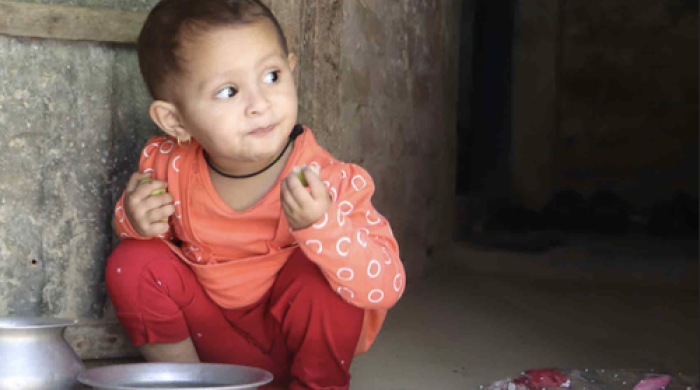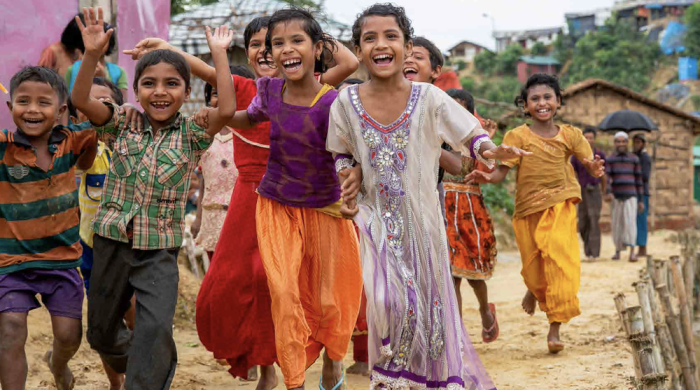NYU Steinhardt’s Global TIES research finds that introducing an Arabic version of Sesame Street, along with support services, helped kids "not just survive, but thrive."
For decades in the US, beloved Sesame Street characters such as Elmo, Big Bird, and Oscar the Grouch have taught children their numbers and letters – along with life lessons, like the value of patience and how to manage their feelings. In an effort to bring that kind of crucial early childhood learning to crisis-affected areas, Sesame Workshop and the International Rescue Committee (IRC) came together in 2018 to launch a new initiative, Ahlan Simsim (“Welcome Sesame” in Arabic), which is now the single largest early childhood intervention in the history of humanitarian response. With support from a $100 million grant from the John D. and Catherine T. MacArthur Foundation, Ahlan Simsim has now reached over 23 million children in the Middle East through a locally produced Arabic language version of Sesame Street. In addition to the TV show, the initiative also includes early childhood programs and services for families, which have reached more than 1.5 million children and caregivers across Iraq, Jordan, Lebanon, and Syria. Through these comprehensive efforts, the Ahlan Simsim initiative focuses on emotional development, teaching counting, reading, and emotional regulation through new characters such as Basma, Jad, Ameera, and Ma’zooza.
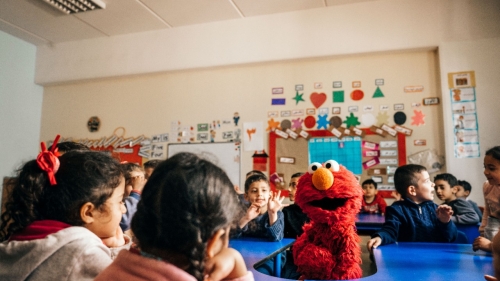
Elmo with children in a classroom in Saida, Lebanon. Photo Credit: Ryan Heffernan/Sesame Workshop.
For help measuring Ahlan Simsim’s impact, Sesame Workshop and IRC turned to Global TIES for Children at NYU, which conducted three studies evaluating the program innovations. One evaluated exposure to Ahlan Simsim episodes shown daily for 12 weeks in Ministry of Education preschool classrooms in Jordan. Another study explored an 11-week remote multimedia program delivered alone and in combination with a supplemental Ahlan Simsim program in which caregivers received additional early childhood development sessions and caregiver support via WhatsApp group calls. The third study evaluated a phone-delivered (audio-only) program in which caregivers in the Middle East received parenting-focused calls along with check-ins about their well-being.
In newly released research briefs, Global TIES summarized the impacts of these Ahlan Simsim programs.
NYU News spoke to Steinhardt professor and Global TIES co-director Hirokazu Yoshikawa about the success of the program and what the research reveals about how to deliver early childhood development programs in crisis-affected areas and other regions without access to universal high-quality preschool.
What were the primary takeaways from your research on this programming?
The big overarching idea behind the Ahlan Simsim project was to provide support to the countries most affected by the Syrian refugee crisis, and to innovate in the area of early childhood development in humanitarian contexts. Can there be community-based innovations in early childhood development, both mass media in the form of an educational TV show and other content, and then on-the-ground services that directly supported young kids and their caregivers and communities? And I think this research shows that there were some important innovations with meaningful and positive effects. I’m so impressed that Sesame Workshop and the International Rescue Committee, working with in-country staff, collaborators, and refugees themselves, produced models with what we now can say is proven impact on supporting children to not just survive, but thrive in these contexts.
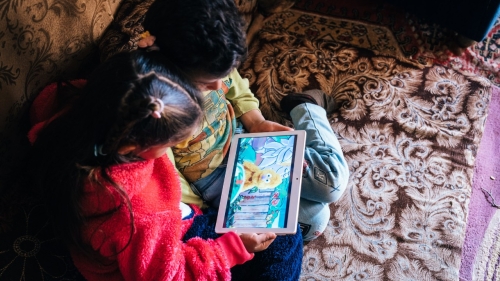
Two children watching the Ahlan Simsim TV show in Saida, Lebanon. Photo Credit: Ryan Heffernan/Sesame Workshop.
Can you talk about what you found in terms of children's emotional development?
In the first study, the actual Ahlan Simsim TV program was shown every day in government preschool classrooms in Jordan for about three months. In our impact evaluation, we showed that it improved children's emotional development – both their ability to recognize emotions in social situations, and to use regulation strategies of breathing and relaxing in the face of strong emotions. This is important because there has not actually been an educational media program for young kids that has focused primarily on emotional development. The ability to identify and cope with emotions is foundational to a bunch of later social-emotional skills, as well as the ability to absorb learning in school and community contexts. This kind of laser focus on emotional development raised a big question: Is it actually affecting children's ability to identify emotions? And our evaluation shows that it is, and this was adding to young children's emotion vocabulary in the context of Jordan. I think this finding shows the value of focusing curriculum and the program on children's wellbeing in a very specific way, and that it produces some of the effects that were intended by the show.
What impacts were found in terms of children’s literacy and numeracy?
That was addressed in one of the other studies, in Lebanon, that evaluated an innovative remote early learning model in response to the COVID pandemic. You can imagine that remote preschool is extremely challenging – picture a bunch of four-year-olds all going off mute on Zoom! So the innovation here was to actually put the power of preschool teaching and pedagogy in the hands of caregivers – in this case Syrian refugee caregivers – in remote and rural areas of Lebanon, where it hasn't been possible to construct preschools. Preschool teachers worked with caregivers three times a week in half-hour sessions to have them carry out the play-based curriculum the IRC had been implementing in person for years – all the kinds of preschool activities that support language and numeracy, and social-emotional development and motor development.
They don't have a lot of access to early education in these parts of Lebanon, particularly for the Syrian refugee families, and so caregivers experience this as important contact with preschool teachers and schools and education. They referred to these sessions, even though they were on WhatsApp, as “school,” which is really significant. And the effects on children’s language, numeracy, and social-emotional development that we saw from the 11-week program were large – on par with what we usually expect as effects of a full year of preschool.
So these are pretty extraordinary findings. We also think this program model is relevant for the fact that globally, we're very, very far from universal access to high-quality preschool education. And this shows that caregivers can play an important role, and may be relevant for not just humanitarian contexts, where families are mobile, but also in rural and remote areas which are usually the most challenging areas of countries to expand preschool into. So we think this will raise a lot of interest, not just from NGOs that work in the humanitarian sector, but also from ministries of education that are working to expand quality preschool to all young kids.
Another extraordinary finding from this evaluation is that the positive effects on children's learning occurred regardless of the caregivers’ education or literacy levels. This really challenges the stereotype that says that caregivers and parents with low levels of education won't be able to support learning at home. We found exactly the opposite – that they can be very highly engaged and have a great impact on their children's learning with the support from teachers.
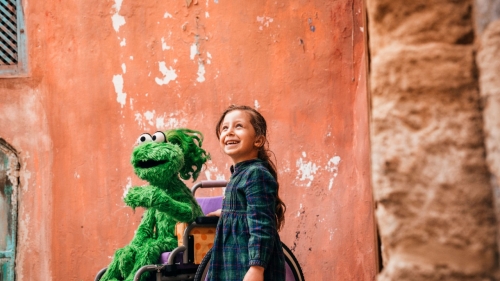
Ameera and a young child in Saida, Lebanon. Photo Credit: Ryan Heffernan/Sesame Workshop.
Were there any findings that surprised you during the evaluation?
The Lebanon remote early learning program also provided learning kits of materials brought to homes, and those were received with incredible enthusiasm. It was so meaningful to both kids and parents to receive this physical aspect of schooling – kids were jumping up and down when materials were being delivered. Despite the fact that teachers weren't actually coming to homes, and the contact was through WhatsApp, the learning materials, which included a lot of the Ahlan Simsim content from the TV show plus IRC-developed preschool materials, were extremely meaningful to families. Siblings were using them too, not just the focal children, and that was surprising.
Teachers were also surprised. Some told us they were initially skeptical about whether caregivers could implement these kinds of activities, but they grew to have really close relationships with the caregivers. They also had one-on-one calls with them, in addition to these group calls, and the caregivers also reported supporting each other on WhatsApp. These kinds of peer friendships and supports were also critical in motivating caregivers to stay engaged in a program like this.
This kind of community building is especially important for these more isolated rural and remote families that are living far away from each other.
What actions regarding early childhood education in crisis-affected areas do you hope to see in the next few years?
With the greater attention to early childhood development in these kinds of migration and displacement contexts, I would love to see refugee voices centered even more in this critical area of early childhood development. And it would be great to see the partnerships that have come out of this initiative – for example, with ministries of education and health in multiple countries – be sustained and strengthened as well. The materials developed from this partnership are in high demand in ministries across the region. That shows that this focus on developing ECD programming in this part of the Middle East was successful in garnering the kind of interest that can lead to even larger scale impact.
What are the limitations of these studies?
Although refugees gave input to develop these program models, more could be done to involve them meaningfully in all the implementation and governance and leadership, and then the next phase of improvement of these programs. We conveyed our results back to caregivers, teachers, principals, and other stakeholders and got a lot of important information. I hope that kind of two-way dialogue can continue so that we generate even more advances in the field that are led by refugees.
What can caregivers, teachers, and government leaders in crisis-affected areas take away from these findings?
One project we evaluated was a COVID pivot – a caregiving program for parents of 0- to 3-year-olds in Jordan. It was provided entirely on the phone, and, unlike with the WhatsApp program in Lebanon, there was no video involved. While it didn’t improve parenting, according to our measurements, it did reduce the caregivers’ depressive symptoms. That came from the fact that the callers were trained to do a general check-in and to engage in active listening techniques that were really critical to this improvement in caregivers’ wellbeing. When we spoke with the caregivers, they spoke about how helpful it was for someone to be generally checking in on their wellbeing, whether it was about their economic stresses or relationship stresses. They came back to these topics week after week, and they looked forward to these calls.
For the teachers in Lebanon, working with caregivers to implement a preschool curriculum was new, and so they reported getting to know families in a way that they never had before. This goes way beyond traditional approaches to family engagement.
For the teachers in Jordan who showed and saw Ahlan Simsim alongside the kids in their classrooms, they not only got 55-inch televisions, but they were watching the episodes every day. They were really enthusiastic about the program. Some of them would pause it and explain what the kids just saw, or do an activity. We didn't provide guidelines for teachers in this case, for how they should use the show. We were simply interested in whether the exposure to the TV show would have an impact on children's emotional development. But the teachers, it turned out, were creative, and did a variety of things on their own because they saw that the content of the program was nutritious for the kids’ development and learning.
I think it would be an important next step to develop formal materials to link the Jordanian kindergarten curriculum with the Ahlan Simsim TV program.
Finally, for policymakers, I think the partnerships with the ministries have been really important. They're a critical part of the Ahlan Simsim initiative because the intent was not to just have IRC and Sesame provide these materials and programs, but to then provide them as a kind of public good to other NGOs, to ministries, and to really have a full-time policy liaison to partner with ministries and NGOs in the region and reach scale with these programs. The materials, curricula and models are in fact currently being adopted by ministries and NGOs across the region – the kind of impact at scale that was central to the vision of Ahlan Simsim.
Related Articles
NYU Global TIES for Children Finds Substantial Impact from Groundbreaking Ahlan Simsim Initiative Combining Educational Media and Early Childhood Services
New research from NYU Global TIES for Children finds substantial impact on children’s language, numeracy, and social-emotional development from Ahlan Simsim programs.
Understanding Settings for Early Childhood Socialization: New Research Brief by Global TIES for Children's Play to Learn Team
NYU Global TIES for Children (NYU-TIES), an international research center embedded within NYU's IHDSC, has launched their sixth research brief, Understanding Settings for Early Childhood Socialization: Evidence from the Rohingya Camps, from their Play to Learn (PtL) program.
New Research Brief by Global TIES for Children's Play to Learn Team
Global TIES researchers show that through analyses of instruments measuring caregivers' perceptions of refugee camp environment, caregiver mental health, and children's social-emotional development, there are reasons for optimism in using these particular scales with the Rohingya community in Cox's Bazar, Bangladesh.


